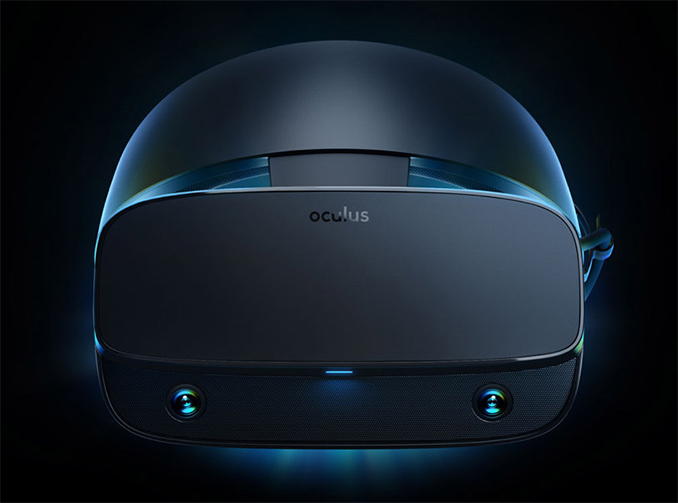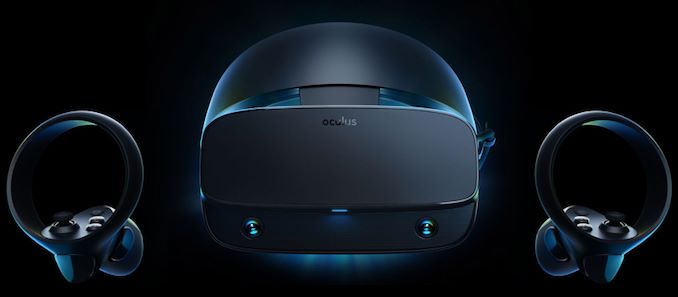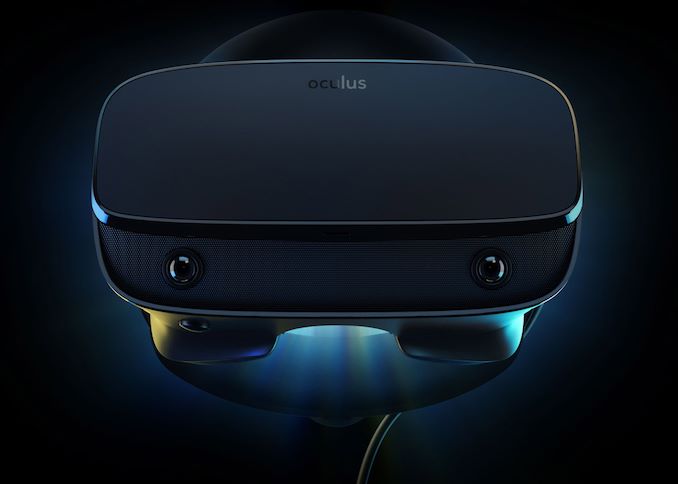Oculus Rift S VR Headset: An Upgraded Virtual Reality Experience
by Anton Shilov on March 20, 2019 2:45 PM EST- Posted in
- VR
- Oculus Rift
- Oculus
- Oculus Rift S

Oculus VR has introduced its new Oculus Rift S virtual reality PC-powered headset. The new head mounted display (HMD) features an inside-out tracking and does not require any external sensors. In a generational update, it has a higher-resolution screen when compared to the original Oculus Rift. The new unit will ship this Spring.
Co-designed by Oculus VR and Lenovo, the Oculus Rift S is a natural evolution (not a major upgrade) of the original HMD that improves it in almost every aspect, including quality of VR experience, a more convenient tracking, and even better ergonomics. The original Oculus Rift and the Oculus Rift S will share the same core platform, enabling owners of both to access VR content developed for either HMD. In fact, even PC requirements for both headsets are the same.
The Oculus Rift S VR headset is equipped with a brand-new display featuring a higher pixel density than before as well as an all-new optics with improved Fresnel lenses for more vivid colors. The company does not disclose resolution of the new HMD officially, but there are claims that the device uses a 5.5-inch display panel with a 2560×1440 (538 ppi, 1280×1440 per eye) resolution and an 80 Hz refresh rate, which is also found inside the Oculus Go. As for audio, the unit has an integrated near-ear speakers in addition to a headphone jack.
The new headset also comes with a built-in inside-out 6-degree-of-freedom (6DoF) Oculus Insight positional tracking (designed for the Oculus Quest) and therefore does not need any external sensors like the original Oculus Rift. Apart from internal sensors, the HMD has five inside-out tracking sensors to track the new Touch controllers and let users observe their surroundings without taking off the HMD.
Because of its collaboration with Lenovo, Oculus VR has managed to develop a headset with a better weight distribution and a more convenient head strap, the company said.
Oculus VR intends to start selling the Oculus Rift S VR headset this spring at a price of $399. The company does not specify the exact launch date, but the wait should not be too long.
Related Reading:
- Oculus Quest Announced: A 6DoF Standalone VR Headset
- Oculus Go Now Available: Mainstream Standalone VR Headset Starts at $199
- HTC Vive Pro HMD Pre-orders Start Today for $799; Vive Reduced to $499
Sources: Oculus, Adam Savage’s Tested, TechCrunch, The Verge












24 Comments
View All Comments
Midwayman - Wednesday, March 20, 2019 - link
Oh I don't doubt inside out tracking is here to stay. At least on the low end. In fact I 100% expect this to be really similar to what is released for the next round of consoles tracking wise. The ease of setup and being able to really put it away is a huge advantage going mass market. However it is undeniably worse tracking.It makes sense for them. Other than the price, it probably makes sense to new consumers of VR. For current VR customers I feel like Oculus has been sending a strong signal they don't care about PC VR. Everyone was hoping that this would have at least the Quest Panels in it, but instead got the Go panels. I don't think anyone was expecting a real 2.0 rift. But its largely a step backwards for current owners. Not even like a 1.1. More like regression.
Opencg - Thursday, March 21, 2019 - link
I think the idea is that they want cameras on it so that you can see your surroundings. And they used the cameras for tracking. They just saw an opportunity to cheap out on tracking and went for it. I could care less about being able to see my surroundings. I would like to see lense replacement supported by an hmd.Dr. Swag - Wednesday, March 20, 2019 - link
Any idea if it's OLED or LCD?BenSkywalker - Wednesday, March 20, 2019 - link
I would imagine it would have to be OLED, LCD isn't a good choice for VR.Cooe - Thursday, March 21, 2019 - link
Think you got this one backwards. The use of PenTile (only 2 subpixels per pixel in an irregular layout) on OLED display's is the major reason for their ridiculously excerbated "screen-door effect" & total uselessness to see fine details or read text. And it requires a MASSIVE leap in nominal resolution to make up for these deficits. This is why Pimax's RGB-stripe LCD based 5K+ unit looks SOOOOO much clearer/sharper image-wise versus their much higher resolution, but PenTile OLED 8K headset. I for one welcome Oculus' shift away from OLED until Samsung stops it with all this PenTile trash, which isn't gonna happen bc $.mukiex - Thursday, March 21, 2019 - link
LCD's main advantages are a better fill ratio 'n full RGB stripes by default.OLED's main advantages are being able to switch quickly (only 3ms out of the 11.1ms in a 90hz frame are actually displaying content in VR to minimize ghosting) and better contrast.
Up until LCDs get something like a +240hz display rate, they're not even going to hope to compare in the former, and that's actually super-important to minimizing VR fatigue. LCD's fine until you wanna play for more than 5 minutes.
BenSkywalker - Thursday, March 21, 2019 - link
What makes you equate pentile with OLED? There have been a lot of LCD pentile displays, and a lot of non pentile OLED displays.I'll phrase it slightly differently, even if OLED had to be pentile, which is laughable, but even if it had to quadrupling pixel density would make it vastly superior even when looking at screen door effect.
If you made LCD pixel response time ten times faster than it currently is, OLED still would beat it badly.
LCD on VR makes it hot trash for anyone that wants to play for more than ten minutes.
I've been waiting for pixel density to get around 4k because of the screen door effect, 16k LCD would just be nausea inducing trash.
sheh - Wednesday, March 20, 2019 - link
LCD.rtho782 - Thursday, March 21, 2019 - link
It's LCD.SunLord - Wednesday, March 20, 2019 - link
Thus is basically an upgraded windows mixed reality headset it's basically ba stro Side ways and backwards.